
Exploring Time and Scale of a Crisis in A Durational Performance with the Sea
When Hurricane Sandy struck the East Coast in November 2012, it completely changed New York artist and director Sarah Cameron Sunde’s perception of time, duration, and scale. Watching the flood waters that caused 19 billion dollars of direct damages in just one night and ultimately took 44 people’s lives cover vast swaths of her hometown, it occurred to her that it was possible New York City — or at least the New York City that she knew — could disappear within her lifetime.
While the idea to do a durational performance had been brewing in her for a long time, it was this moment of extreme vulnerability in the rising waters of the place she’d always thought of as invincible that made it clear she had to start swimming, or rather, standing up. Realizing that these extreme weather events caused by climate change were no longer abstract futuristic scenarios, she began to explore the questions of how we as humans could respond to this new reality and how that might feel in our bodies.
The premise of what has since become 36.5 / A Durational Performance with the Sea — 36.5 °C is just below normal human body temperature and 36 1/2 was Sunde’s exact age on the day of her first performance, thus tracking her own personal timescale in a literal and symbolic way — was simple: Sunde would walk out into the water and stand there for a full tidal cycle, letting the water rise up to her chin and drop back down to her feet over the course of 12 to 13 hours. The local community would be invited to stand with her for however many hours they wanted, to feel the change on their own bodies. The whole performance would be live-streamed in real time with multiple cameras from different angles by a local cinematographer and crew, then turned into a multichannel video installation showing different moments in time.
Seven years later, 36.5 / A Durational Performance with the Sea has been staged in six iterations across five continents, from Maine and San Francisco in the U.S. to The Netherlands, Mexico, Bangladesh, and Brazil. The plan is to cover all six continents to connect these ideas on a global as well as hyperlocal scales, with nine performance works in total, six of them fully formed durational video works. 36.5 is currently on location in Kenya, with planned performances in New Zealand in early 2020 and a New York homecoming around Climate Week in September 2020.
The Art of the Green New Deal caught up on the phone with Sunde this summer during one of her rare free moments at home to find out more about the origins of the project and some of the revelations it has brought.
I was thinking about how these same drops of water that are touching my body may also have been off the coast of Bangladesh. How it’s pulling all of us at the same time, and the power of that pull through the water.
How did you get from escaping the rising flood waters during Hurricane Sandy to voluntarily letting rising tides come up to your neck?
I was working on another project at the time called “Born for Nothing” about an artist struggling to get by on a daily basis. So I kept on imagining this little artist walking around New York City and the city is just covered in water and sinking beneath that artist’s feet. And all of a sudden the artist looks up and realizes it’s too late. So I was trying to work in that parallel — the individual struggle for daily survival and the struggle for humanity to survive these rising sea levels.
Later that year, when I was up in Maine for an artist residency, I was taken by the tidal shifts. I couldn’t stop watching it. I realized how drastic the change was in such a short amount of time, going from an almost ugly environment (laughs) to this big beautiful blue bay of water. Then one day I watched these rocks slowly getting swallowed by the water and I realized, “oh my god, those tides are a perfect metaphor for environmental change.” I had this moment when I was watching a clock and I imagined a person standing out there, and I thought to myself “how do I make this image?”
The director in me was thinking, “okay, who can I convince to stand in the water for 12 hours and 48 minutes?” and I realized that no one would ever do that for me. So if I wanted to create this imagery, I would have to do it myself. I had one more week in Maine, so I said, “okay, here we go, I’m just going to do it.” And that’s how it first happened. I didn’t know whether I’d be able to do it, but somehow, because I framed it as a performance and my fellow residents were watching me, it was that pressure that actually made me do it.
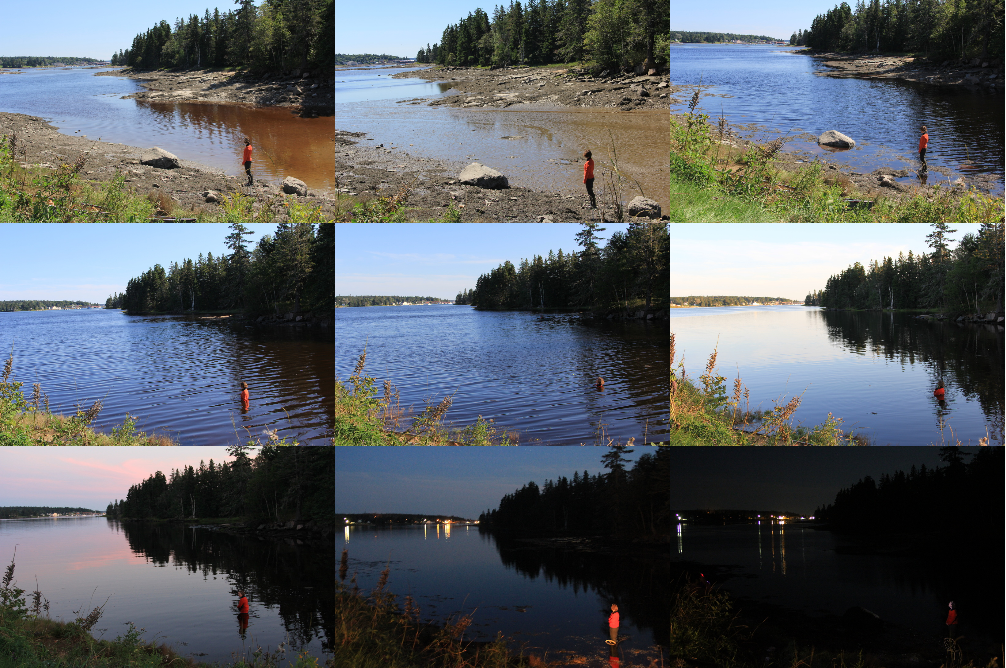
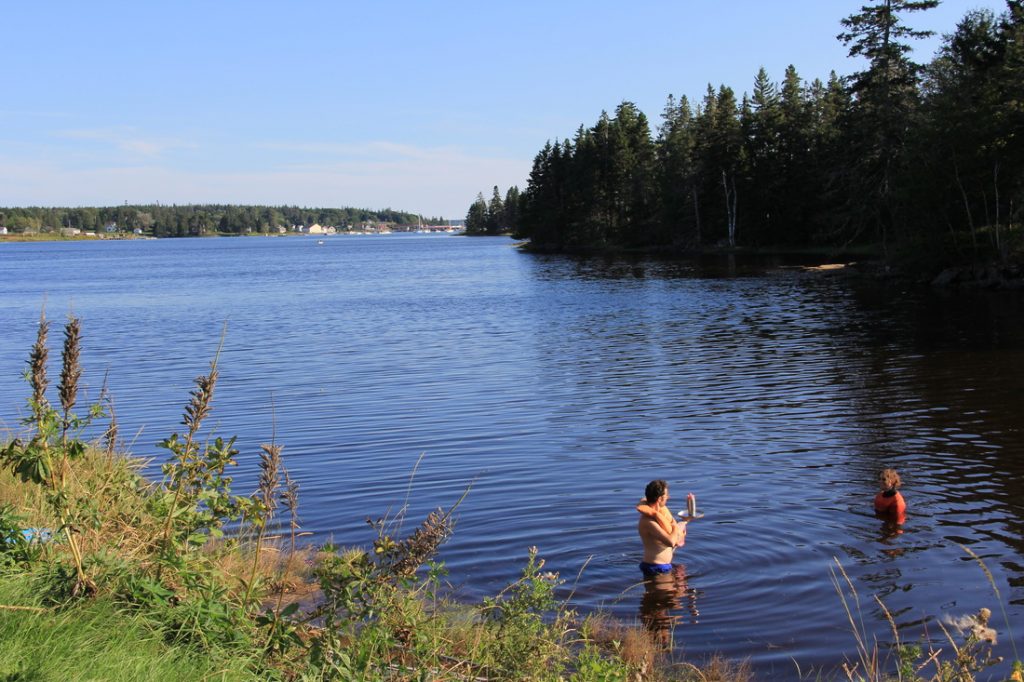
That’s amazing. Standing there for 13 hours the first time must have been really exhausting!
You know, everyone who does durational stuff says this, but what I felt was “that was so hard but I feel so alive!” Just the fact that I made it through was the ultimate high. So much of it is mental. I remember a distinct moment as I was watching the moon rise, when I got distracted by the current. I looked down at the water around my body and started paying attention to that. The next time I looked up I was like, “oh my god, the moon has moved! How did I miss that moment?”
I realized the immensity of everything, and I had a sensory connection to everything that was happening all over the world at that moment. I was thinking about the tides and how the moon is controlling it all, connecting all this water. How these same drops of water that are touching my body may also have been off the coast of Bangladesh. How it’s pulling all of us at the same time, and the power of that pull through the water.
It occurred to me that there are all these other people in other parts of the world who are dealing with these challenges, and I wondered, “What will happen to them in the future? What’s happening to them already? And, how are they coping? How are they seeing this relationship with the water and what can I learn from it?” That was the moment when I thought, “Okay, this is a series. I’m going to do this in different parts of the world, connect with communities there, and try to understand how they’re dealing with it.”
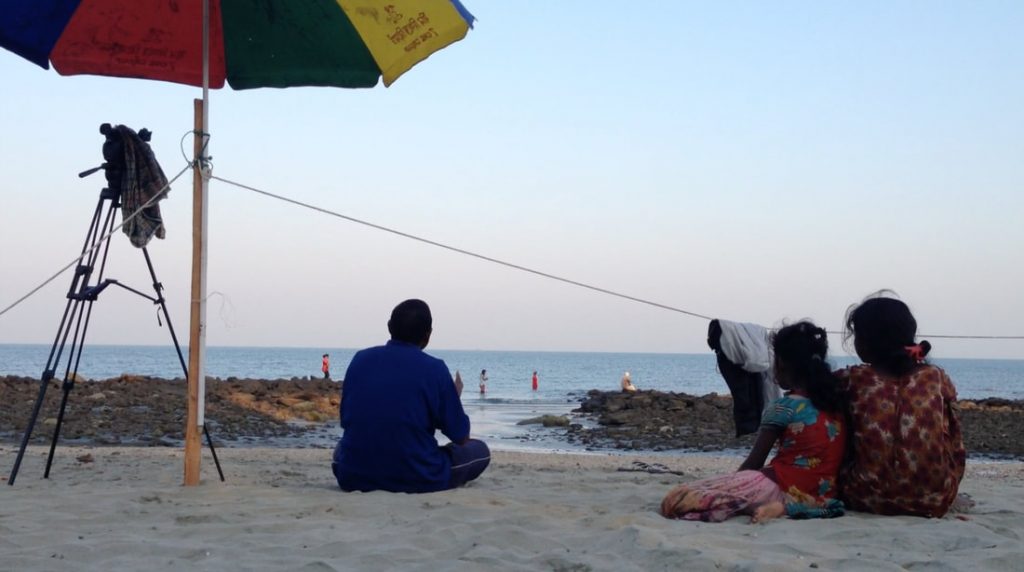
In light of ever more news about a melting arctic 36.5 is in some ways a human mirror of what’s happening in nature. Have you been feeling a shift emotionally or physically as you’ve been standing in the water?
I do feel like there has been a shift in general awareness about climate change. When I first started the project in 2013 and mentioned sea level rise, so many people didn’t even know what I was talking about. And now, of course, everyone knows that sea levels are rising. There are still people who believe we shouldn’t be doing anything about it, but everyone knows the problem exits. And so understanding how culture shifts through time and that we’re in this moment of urgency trying to figure out how to do something about it as fast as possible, I believe people need to feel it in their body. That’s what’s going to impact and change a large part of the population, which ultimately leads to policy changes.
My work also tries to encourage dialog with strangers. It happens over the course of 12 or 13 hours where you’re sitting on the shore and there’s not that much happening (laughs), so you spend the whole day talking to people about what this is and what’s going on. So that serendipitous dialog that occurs in the relationship to the work allows us to reflect on how these changes affect our own lives. Having that longer space and also the artistic perspective does allow for a different way into the topic than our normal daily conversations where it can feel very polemic. There’s a deepness in the artistic recognition that I believe in as a way to move people.
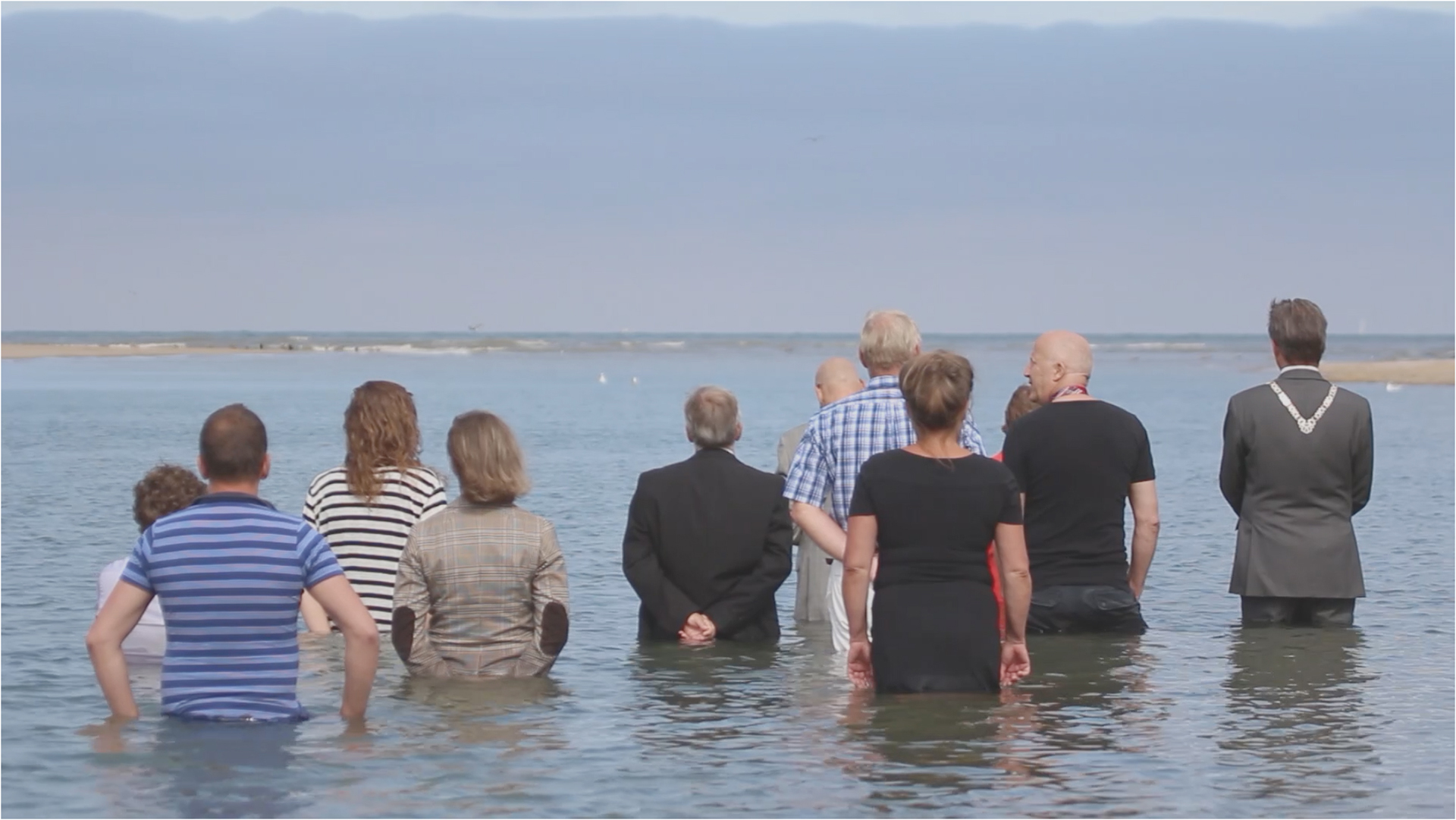
Can you talk a little bit about the role of the communities on the ground in your performance?
One thing you learn when you do a project in other parts of the world is that it requires a lot of time to build a deeper connection with the local community. You can’t just plop down somewhere and say, “Here I am, facilitate my art.” First you have to find a place where you want to be doing it. Then you have to find the people who will be invested in it as a work they want to co-create.
Although I may have a very clear concept of the piece, it’s really open to what the community brings to it. The only continual thread is me standing in the water for the whole time. Other than that, what it becomes in the site specific location really depends on who I meet and how they engage with the work. What are the things that are on their mind? The heart of it really is to connect to people around the world and explore the complexity of the relationship between local and global issues. If I’m talking about the global situation I have to talk about other localities besides my own. As my friend Nicole Miller put it, the project is an individual and collective investigation into vulnerability and resilience.
One thing you learn when you do a project in other parts of the world is that it requires a lot of time to build a deeper connection with the local community. You can’t just plop down somewhere and say, “Here I am, facilitate my art.”
Has the community engagement changed the project in ways you didn’t expect?
It’s not so much that the project changes, but it grows and becomes more complex. For example, in Bangladesh, a passerby spontaneously decided to play his mandolin for me for a full hour. I could see him out of the corner of my eye, perched on a rock in the water with me. He was sad, I could feel it. Since I don’t talk while I’m out there I tried to give him a thank you with my body. But he didn’t really respond and I thought, “Wow, something intense is going on here.”
I found out later that he was a Rohingya who had escaped persecution in Myanmar. His two brothers had been shot by police and he had run away and smuggled himself across the water to St. Martin’s Island in Bangladesh, with just the clothes on his back and his mandolin. I had never even considered tying the refugee crisis into this work, but here it was, it just happened. So that connection to him and what that brings to the work opened up all these other questions: what does survival mean in relationship to water?
Another example was in Brazil, where the spot I picked was right in the urban part of Salvador, right near very elite as well as underserved neighborhoods. I had gone over there thinking, “Oh, everything is so multicultural in Brazil,” not realizing just how intense the prejudice there is and the challenges that come with it. So all of a sudden bringing these different communities into the conversation becomes a huge theme and working with an artist-anthropologist as a community liaison critical to how the work gets made.
When we got there two weeks before the scheduled performance, the water was crazy. The winds were blowing, the waves were coming in hard, and the tides were ridiculously high. It was just wild. I went back and forth for two weeks wondering if I’d be able to pull it off. It was a real struggle to decide whether I should choose another spot and pay for everyone’s transportation, or just stay there and risk failure. But then, because of all the community work we had done, I was thinking to myself, “I can’t stop now, I’m committed to all these people!” So I ended up staying, partly because it just didn’t feel right to leave, but also because I was interested in what the experience would feel like.
In the process my idea about resilience changed because I had to reconcile my idea of that word in relationship to the image I’m trying to create. I had always thought that I’m creating this image where I’m still and the water moves around me, but all of a sudden here I am in a situation where at a certain time there’s no way I can stay still anymore. I had to reframe what that would mean and I realized that resilience should mean “let the water move you.” There’s no way I could have anticipated that, it’s just the way it happened. And learning what I learned about Brazil being so passionate and so challenging, it made sense to me that the waters were wild and that I just had to go for it, and that that becomes a big part of the story of the work.
Bay of All Saints – Salvador, Brazil
You standing in that tide really puts people in the head space that allows for more long-term reflection. We viscerally understand that the tides are changing even though we can’t see it in the blink of an eye. It makes people more aware of time and how we compartmentalize climate change as something far off in the future. So you’re really setting the tone for a deeper understanding of both how slow and how fast time is moving.
Absolutely. The relationship of time, duration, and scale is all I’m thinking about in terms of how to open up people.
You’re coming home to New York in 2020 which is also election year and will determine whether we have a Green New Deal. Do you think 36.5 could be tied into talking about solutions, and if so, how?
Yes, I absolutely think that this could be tied into solutions. I used to say that the first step towards resilience is awareness. The power of art is to create a perception shift that’s emotional. It changes you without having to have a disaster occur. If many more people could have the space in their bodies to contemplate what climate change or sea level rise means for us now and what it will mean in the future, I believe we wouldn’t be putting up with not doing anything. The zeitgeist would just shift if there could be a shift in perception across boundaries and with many many people.
As far as New York, If I can get the funding I want to do deeper community engagement all around NYC as part of my final performance during Climate Week in September 2020. The idea is to have several representations of the project and people gather all around the city. And also have reenactments around the world where I’ve already done it in the past, on that same day. I think of it as trans-oceanic communication around the world. If I can find the resources and partnerships to make it happen on that scale I believe it can have a serious impact in terms of shifting consciousness.
Well, we hope we can do our part to help you get there. Thank you so much for taking the (short) time to talk with us.






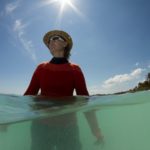












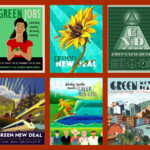
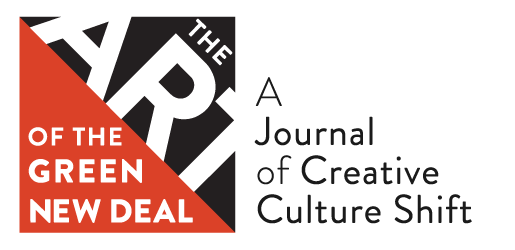
Sorry, the comment form is closed at this time.